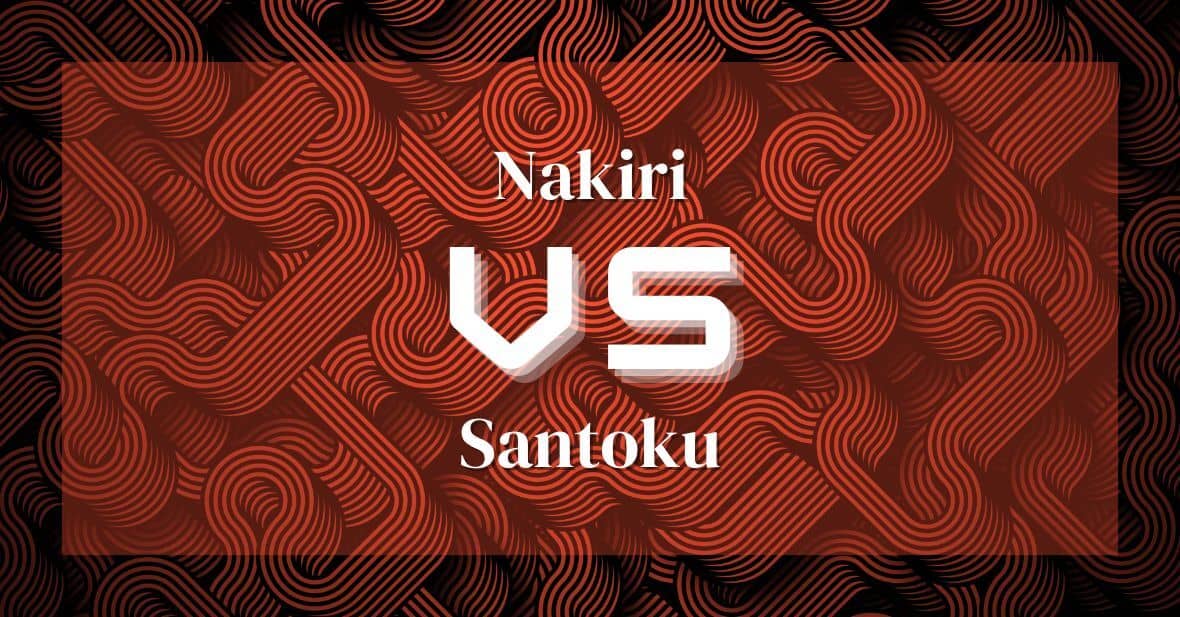Nakiri vs Santoku: Battle of the Versatile Japanese Knives
Hey there, you’ve come to the right place if you need to know about the difference between nakiri and santoku knives. If you’re a cooking enthusiast or professional chef, it pays to be familiar with these two types of blades. They both look similar but there are some subtle differences that could make all the difference in your kitchen!
We’ll explore blade design, edge retention, weight and balance, handle material and price and availability in this article. So let’s get started discovering which one is best for you!
Blade Design
Discover how the design of a blade can make all the difference in your cooking experience!
From the steel type to grip comfort, nakiri and santoku knives are designed with different features that determine their respective uses.
Nakiri blades are flat, rectangular-shaped knives that have squared-off tips. These blades are made from high-carbon stainless steel and feature an ergonomic handle for a comfortable grip. This design allows them to easily mince vegetables and fruits for salads and other dishes.
Meanwhile, santoku blades are shorter than nakiris and feature indentations along the length of the blade. This unique design helps prevent food from sticking to it while cutting. They also include a slightly curved edge which is useful when chopping up herbs and spices. The handles are usually made out of wood or composite material for a secure hold during use.
So, if you’re looking for versatility in your kitchen, consider investing in both a nakiri and santoku knife – they’ll make meal prep effortless!
Edge Retention
You’ll be amazed at how long the sharpness of these knives lasts – it’s like they never go dull! When it comes to edge retention, both the nakiri and santoku knives have a lot to offer.
The nakiri knife is designed with a thin blade that allows for precise cutting and slicing, while the santoku has a thicker blade that provides more stability when chopping. Both knives are made from high-quality steel, which helps them retain their sharpness over time.
Not only do they provide excellent cutting precision, but they also have an aesthetic appeal that will make your kitchen look great! With either of these knives, you can rest assured knowing that your food will be cut with precision and accuracy every time.
Plus, you won’t have to worry about constantly sharpening them as their edges will stay razor-sharp for years to come!
Weight and Balance
Feeling the balance of a knife in your hand is important for precise slicing and chopping, and both the nakiri and santoku knives provide just that!
The Nakiri has a heavier blade, giving it better control with larger cuts. On the other hand, the Santoku is slightly lighter, but still offers enough weight to feel comfortable when spending long periods of time in the kitchen.
When it comes to sharpness comparison, both offer great durability and edge retention. However, if you’re looking for more precision cutting, then go with a nakiri. For those who need quick chopping action while prepping meals then opt for a santoku!
Here are some bullet points on their weights and balances:
- Nakiri: Heavier blade = better control with larger cuts
- Santoku: Lighter blade = comfort during longer sessions in kitchen
- Sharpness comparison: Both offer great durability & edge retention
- Balance comparison: Precision vs Quick Chopping Action – Nakiri has a more balanced feel due to its heavier weight, while Santoku has a lighter feel and is better for quick chopping.
Handle Material
Comparing the handle materials of a nakiri and santoku knife, one will find that they both offer comfortable grips for precision and quick chopping, yet each has its own unique characteristics.
A nakiri’s handle is usually made of wood or plastic, which makes it lightweight and easy to maneuver. A santoku has a more rigid handle made of stainless steel or metal alloy; this adds weight but also provides more control when cutting.
While both knives’ handles are relatively easy to maintain in terms of sharpness comparison and maintenance requirements, a wooden nakiri may require more frequent cleaning due to its porous nature.
Ultimately, no matter what type of handle you prefer – whether it’s light or heavy – either a nakiri or santoku knife will provide an excellent grip for efficient chopping.
Price and Availability
When it comes to price and availability, nakiri and santoku knives can vary widely – from affordable kitchen essentials to luxurious investments. If you’re looking for a knife that won’t break the bank, then a nakiri or santoku is an excellent choice. Both are incredibly durable and portable, making them ideal for home cooks who want something reliable without spending too much money. On the other hand, if you’re looking for something more luxurious, there are plenty of high-end options available as well. These knives tend to be made with higher quality materials and feature intricate designs that make them stand out in any kitchen. No matter what your budget is, there’s sure to be a nakiri or santoku knife that fits your needs perfectly!
Conclusion
You’ve heard of nakiris and santokus, but what’s the difference between them? They both have unique blade designs, edge retention, weight and balance, handle materials, and price points.
In the end though, it comes down to personal preference. When comparing them side-by-side, you can’t help but be amazed at how different they are. It’s like day and night – one is a light saber while the other is a samurai sword!
So if you’re looking for an all-purpose kitchen knife that can do it all, go with a santoku. But if precision cutting is your thing, then nothing beats a nakiri. Either way, you won’t be disappointed!
Frequently Asked Questions
What Is The Difference Between A Nakiri And Santoku Knife?
Well, think of a nakiri like a samurai sword – its long blade is perfect for chopping onions and other large vegetables in one swift motion. On the other hand, a santoku is more like an all-purpose kitchen tool – its shorter blade makes it ideal for precision cuts when you need to dice carrots or mince garlic. You can always read about all the differences in our head to head comparison.
How Are They Used Differently?
A nakiri is perfect for chopping vegetables, as its flat blade makes it easy to cut all the way through them. A santoku is better suited for slicing and dicing, making it ideal for preparing meats and fish.
What Is The Best Way To Sharpen A Nakiri Or Santoku Knife?
There are some great techniques you can use to keep your nakiri or santoku knife in tip-top shape. The most popular ones include honing with a steel rod and using a whetstone, as they offer the best results.
If you opt for a whetstone, make sure you choose the right one for your specific type of blade – coarse-grained stones work best on dull knives, while fine-grained stones should only be used on blades that aren’t too blunt or chipped.
How Do Nakiri And Santoku Knives Compare To Other Kitchen Knives?
Unlike many other kitchen knives, these two Japanese blades are made from high-quality steel, giving them superior sharpness and durability. Not only that, but their unique blade shapes make them ideal for a variety of tasks in the kitchen.
What Are The Pros And Cons Of Each Type Of Knife?
When it comes to kitchen knives, nakiri and santoku are two of the most popular options. Both offer impressive cutting techniques, as well as different advantages and disadvantages depending on your needs.
Nakiris boast a long, rectangular blade that is perfect for chopping vegetables. Its design allows you to use both horizontal and vertical cuts with ease.
Santoku knives feature a shorter but broader blade which makes them ideal for slicing meat or fish like butter.
Additional Resources
19 Types of Kitchen Knives & Their Uses
Western Style Knives 101 | A Comprehensive Introduction to the Basics
The Art of the Slice: A Dive into Japanese Knife Types
Unveiling The Mystery: What Is A Santoku Knife Used For And Why You Need One
What Is a Nakiri Knife Used For? Unlock the Secret to Flawless Vegetable Prep
Forging Culinary Excellence: The Best Steel For Kitchen Knives

